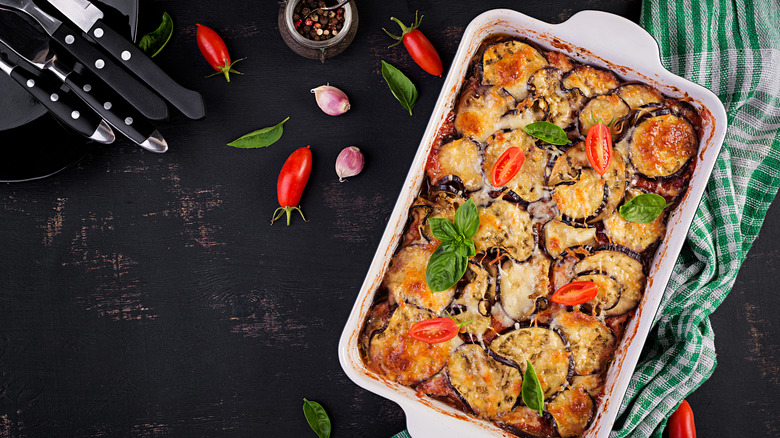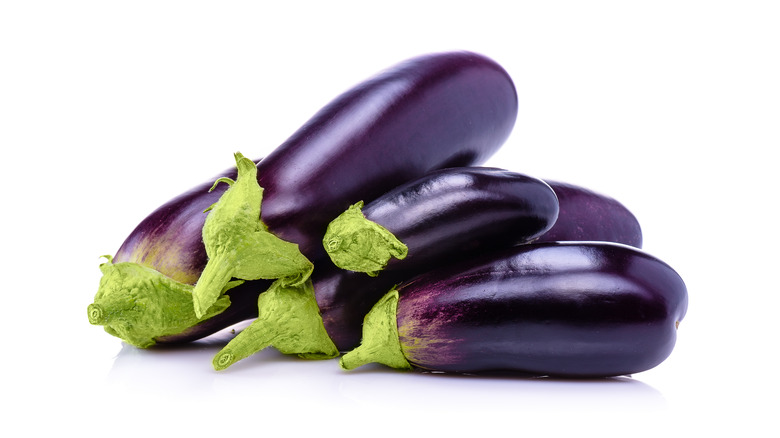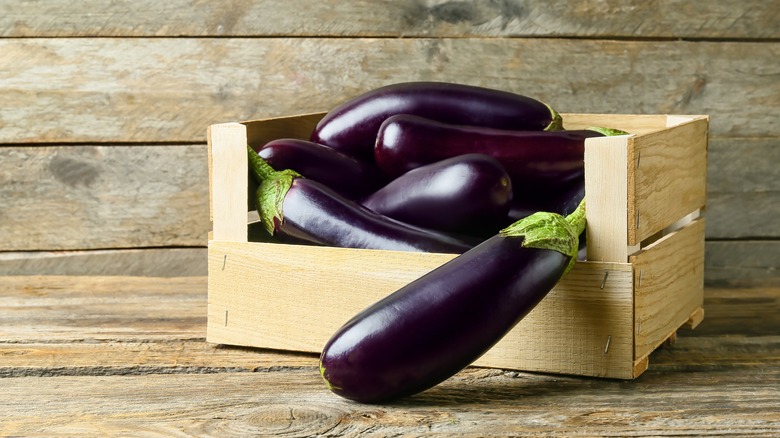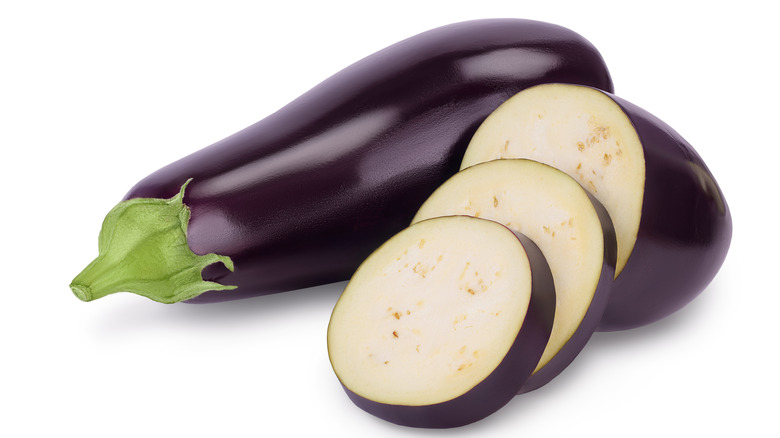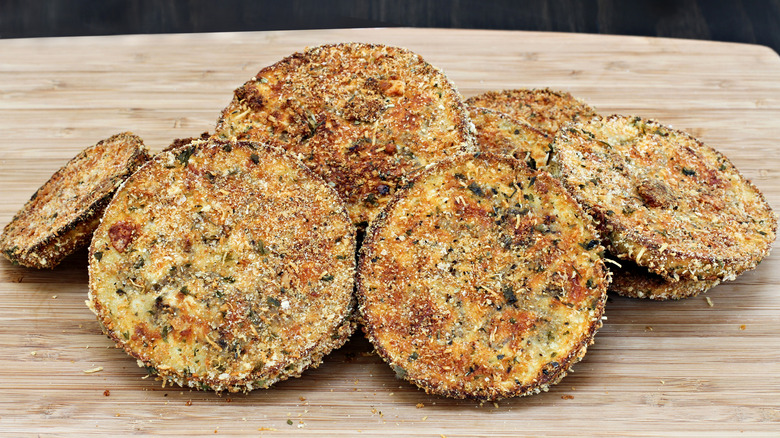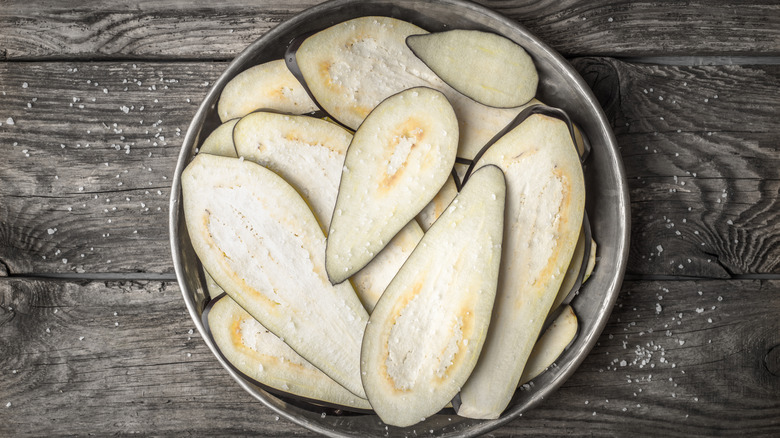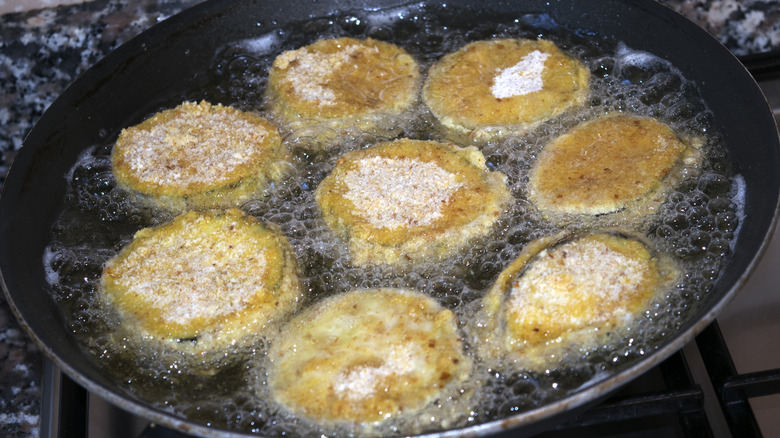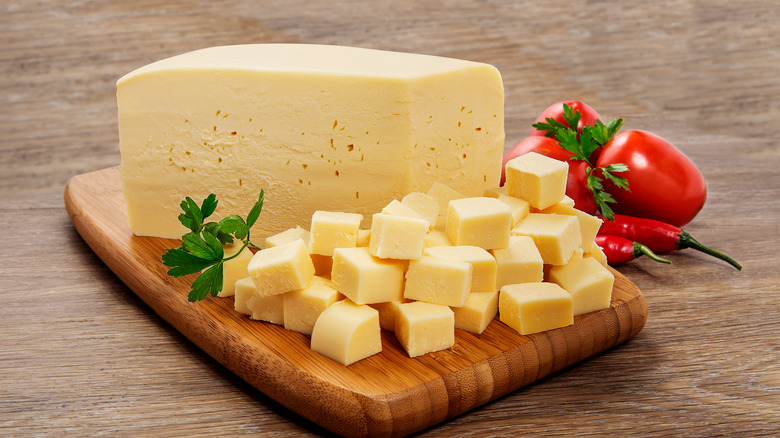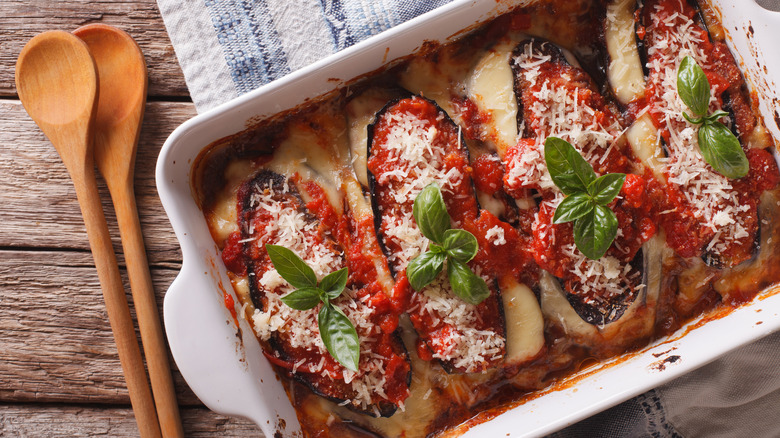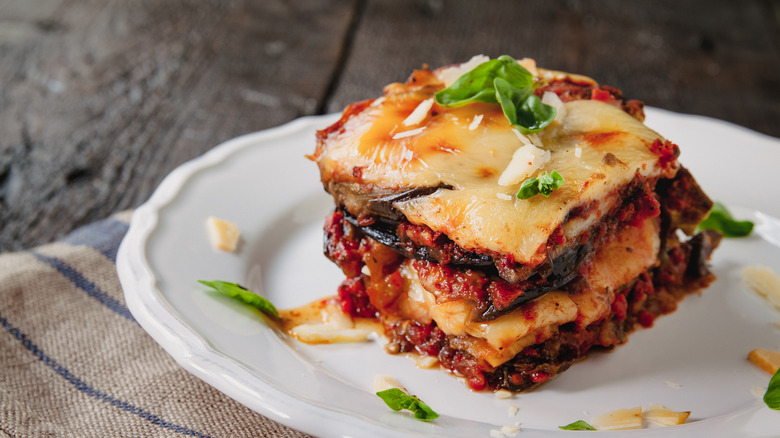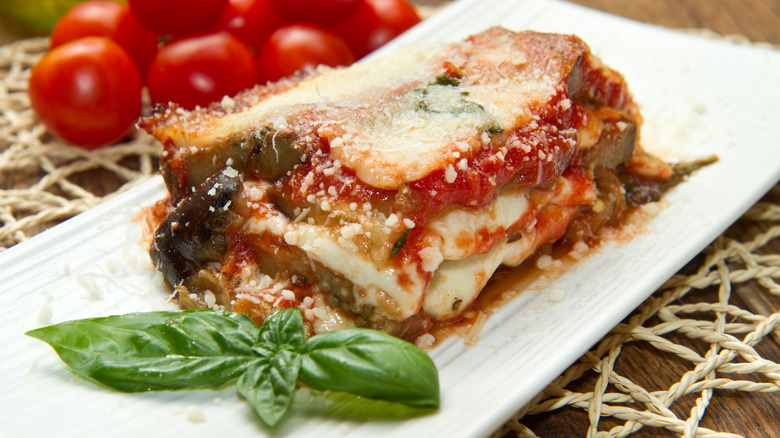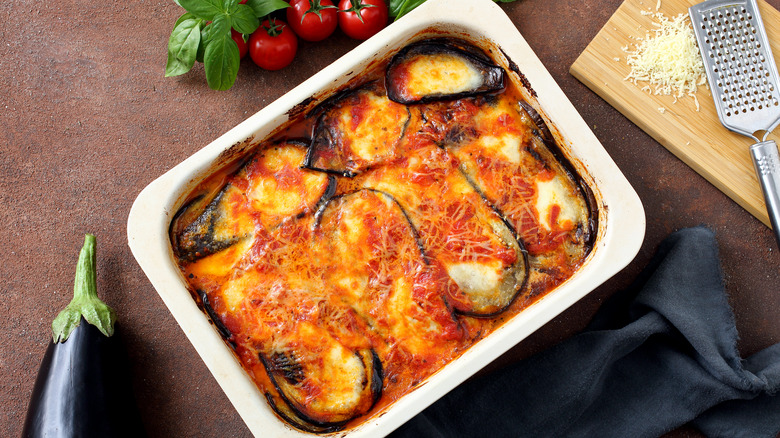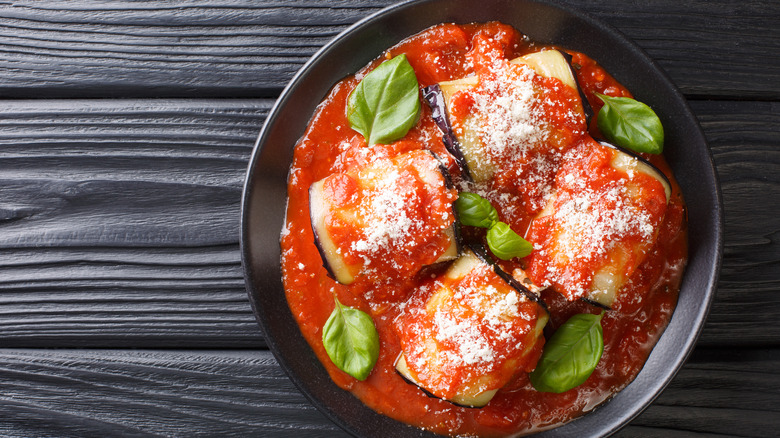13 Mistakes You're Probably Making With Eggplant Parmesan
Eggplant Parmesan is a classic Italian dish. This traditional Sicilian dish combines fried slices of eggplants nestled between layers of tangy tomato sauce and slathered in chunks of melted cheese; it is a decadent meal that delivers every time. Throughout Italy, different regions have their own versions of the dish, remaking it with local cheeses and ingredients.
The Italian American version is often served on a bed of spaghetti, making it quite distinct from the classic recipe. Many home chefs have tried remaking the classic eggplant Parmesan and often seem to make the same mistakes with the dish. They are mostly simple mistakes, and with a little practice, you can learn from them so you can make the best eggplant Parmesan each and every time.
If you are new to cooking this classic dish, you can learn everything you need to know, avoid these mistakes, and add classic eggplant Parmesan to your repertoire of favorite dishes to make that everyone loves.
Not using the right eggplant
It sounds simple, but it all starts with the right eggplant. It can be confusing to choose what kind to use since there are many varieties of eggplant, and some work better than others. The best eggplant to use for classic eggplant Parmesan is the Sicilian eggplant. It is shiny and light and looks similar to the Globe eggplant but is smaller and lighter. The Globe or American eggplant is the kind that most are familiar with, both from the supermarket and the emoji. If you have trouble finding Sicilian eggplant in your supermarket, though, you can also use American eggplant for the dish since it is more widely available year-round.
The best way to choose an eggplant is to look for one with shiny bright skin that feels heavy; if the skin is wrinkly or discolored, it is past its prime. Eggplants should feel firm and dense or heavy. If it feels too soft, that means it is overripe. As eggplants age, they tend to get bitter. Also, the larger the eggplant, the more seeds it has, which also contributes to bitterness — so, in this case, size does matter. Choose a medium size to small eggplant for best results.
Storing eggplant wrong
After choosing the right eggplant, you will need to store it properly before you use it. Ideally, you should not store it too long before you slice it up for eggplant Parmesan. The best way to store eggplant is on the kitchen counter. Eggplant is part of the nightshade family, and like tomatoes, they are both nightshade fruits — yes, they are fruits and not vegetables. They do not like cold temperatures, so they should not be refrigerated. Similar to other popular nightshades like tomatoes, peppers, and potatoes, eggplants prefer a room-temperature environment.
If you live in a warm climate or it's the summer season, storing eggplant in the pantry or another cool, dry place is the best option since they don't do well in the heat either. They are also sensitive to ethylene, which is a gas that some produce emit as they ripen. While it's harmless to some fruits and vegetables, eggplants are sensitive to this gas, and it can cause them to spoil faster. So store eggplants away from ethylene-producing produce like apples, potatoes, and bananas.
Cutting thick slices
Sharpen your knives before making eggplant Parmesan to get the perfect slice. One common mistake many make with eggplant Parmesan is slicing the eggplant into thick, heavy slices. You want the slices to be uniform in thickness, but they only need to be about a ½ inch thick. If you have knife skills and a steady hand, that should not be difficult, but if you struggle to keep them the same thickness, you can use a mandoline to ensure they are all the same size.
Another common mistake is the leaving peel of the eggplant alone. While the peel has many nutrients, it can be bitter, but if you remove the peel, the slices become mushy and lose their form. The best way to keep the structure without losing texture is to peel the eggplant in stripes. Peeling the eggplant into zebra stripes removes some of the peel's bitterness while maintaining the dish's overall structural integrity.
Getting the breading wrong
Breading and frying is an art form. Getting the batter just right and the breading to stick evenly is a skill that even the most experienced home chefs find challenging. And in the case of eggplant Parmesan, the most important factor is the flour dredge.
Breading and frying the eggplant slices are part of the classic recipe, and if you skip this part, it can lead to soggy, mushy eggplant slices. The breaded fried slices are able to keep their shape and act as a barrier to the melted cheese and tomato sauce. But not any flour will do for breading. The best way to bread the slices without them getting too heavy is to use 00 flour. This type of flour is light and has the consistency of fine baby powder. It creates a light breading that is sturdy enough for the slices to keep their shape but light enough that you won't feel like you are eating a heavy fried batter.
If you don't have 00 flour, you can also use panko, a light Japanese bread crumb mix that will yield similar results.
Not sweating the eggplant
Eggplants are nightshades with bitter compounds, and they need to sweat out some of that bitterness before they are ready to cook. No, we aren't suggesting taking your eggplant to the gym for a workout. Sweating the eggplant just means adding salt to the slices and letting them sweat out some of the bitterness.
Salting eggplants is the traditional way to remove bitterness, and the practice is debatable since over the years eggplants have been bred to be less bitter. Nowadays, salting eggplant to sweat before using them is considered unnecessary. But depending on who you talk to, some chefs still swear by salting. And in the case where the eggplant is going to be fried, most agree that salting is still a necessary step because it improves the taste and helps remove some of the moisture from the eggplant, so the texture keeps its integrity.
If you are planning to grill or roast the eggplant slices, then you could opt out of this step, but for true classic eggplant Parmesan, the salting is still required; just ask any nonna, and she will agree.
Using too much oil
One thing to remember about eggplants is that they are spongy and will soak up oil, making a soggy mess. A common mistake that leads to this mushy mess is using too much oil. Of course, you want to fry the slices, but they do not need to be deep fried. You want them to have a crispness that will stand up the other soggy components, the melted cheese, and the tomato sauce. The breading creates a barrier to help keep them from absorbing too much oil, but using the right kind of oil is also important.
Lightly frying the eggplant slices in olive oil is the best way to cook them for eggplant Parmesan. Vegetable oil will work, but it's a bit heavy. And extra virgin olive oil, which has the best flavor for salad and dips, isn't ideal for frying because it has a low smoke point. Medical News Today explains that using an oil that is heated to its smoke point can become carcinogenic, so it's important to use the right oil (and not too much of it).
The other common oil-related mistake that many home chefs fall prey to with eggplant Parmesan is thinking they need to add oil between each layer of eggplant. Adding oil to the layers is going to make a big mess. Not only will the whole dish be too wet, but it will also keep you from cutting clean slices.
Crowding the pan
When you are cooking and have multiple things happening at once in the kitchen, it's easy to want to rush through and multitask to get everything done. Crowding the pan with too many slices of eggplant may seem like a good idea to move quickly and get to the next step in the recipe, but it's not the time saver you think it is. Crowding the pan when frying lowers the temperature of the oil and it releases the moisture of the eggplant, which creates steam. So when you overcrowd a frying pan with slices of eggplant, the lower temperature of the oil mixed with the moisture and steam that releases it keeps the slices from browning properly.
Keep from overcrowding the pan by working in small batches. Yes, it will take longer, but perfection takes time, and if you want your eggplant slices to be perfectly crispy on the outside and chewy on the inside, then don't make the mistake of overcrowding.
Not using the right cheese
There is some variation from region to region on the best cheese to use in eggplant Parmesan. A soft melting cheese is ideal because it holds the entire dish together. The traditional Sicilian eggplant Parmesan calls for Sicilian cheeses like Sicilian Pecorino, caciocavallo, or scamorza. In Naples and in most Italian American versions of eggplant Parmesan, mozzarella is the cheese of choice to bind those layers of eggplant together.
Mozzarella is widely available, so it's common for home chefs to reach for it to melt those eggplant slices together. But it's important to get the right kind of mozzarella. Fresh mozzarella is a tasty choice, but it will add too much moisture to the dish. Instead, a low-moisture mozzarella is ideal because it melts easily without watering the layers down.
Ideally, home chefs should avoid using sharp cheeses like cheddar, which melts well but is too strong for the recipe. Likewise, cheese that has a strong flavor, like blue cheese, aged gouda, and Swiss, are not good options.
Using too much sauce
If you have ever eaten pasta in Italy or eaten in a truly Italian restaurant in the U.S., one thing that you may have noticed is the sauce. Italian dishes generally go light on tomato sauce compared to those same dishes in Italian American restaurants in the U.S. which serve the sauce with a heavy hand. A good sauce should enhance a dish and not drown the key players.
Eggplant Parmesan deserves a delicious sauce, but the dish shouldn't be flooded with the stuff. For one, tangy, acidic tomato sauce will overpower the taste, and the texture will suffer too. Adding too much sauce to your eggplant Parmesan will result in soggy eggplant Parmesan soup.
Traditionally the tomato sauce for eggplant Parmesan is made with passata, which is an uncooked tomato puree. But you can make it from crushed tomatoes too. The sauce doesn't need a lot of extras, and in some regions, it doesn't even contain the classic onion and garlic, which are common in many Italian dishes. In the traditional recipe, the sauce is pure and simple tomatoes puree and some basil and salt. So keep the sauce simple and use enough to cover the layers, but not too much.
Building it wrong
Eggplant Parmesan is an architectural delight. Layers of eggplant with cheese and sauce are the basic building blocks. The classic eggplant Parmesan structure starts with a greased baking dish, then a layer of sauce, a layer of eggplant, another layer of sauce, and a layer of cheese. Then this is repeated to get three layers of eggplant. The dish should be finished with a sprinkle of freshly grated Parmesan or Grana Padano cheese.
The traditional layering is similar to lasagna, with melted cheese and tomato sauce between layers of eggplant. The name eggplant Parmesan is believed to have come from this layering technique that resembles the Sicilian slatted window shades and is surprisingly not connected to Parmesan cheese.
Bold home chefs with a desire for order in the chaos have created a new pristine way of making the dish in stacks. Eggplant slices of the same size are neatly stacked on top of each other with the sauce and cheese. So each diner receives a neatly arranged stack of eggplant Parmesan. If you are serving a large group and prefer the orderly look of stacks, as long as the order of ingredients isn't altered, stacking instead of layering is fine.
Undercooking
It is difficult to overcook eggplant. It is one of those vegetables that, if made right, will keep its structure. But undercooking eggplant is another story. Undercooked eggplant will ruin your eggplant Parmesan. The texture of undercooked eggplant is tough and spongy at the same time. Ideally, the texture should be firm enough to sink your teeth into but with a crisp outside and a chewy inside. But when the eggplant is undercooked, it makes for a mouthful of unpleasantness.
Unfortunately, this is a common mistake when making eggplant Parmesan, and it's easy to see why. Since the eggplant slices are breaded and fried, it's easy to think all you need to do is pop it in the oven just long enough until the cheese melts. But ideally, you need to cook the entire dish a bit longer because you want the cheese to melt into the sauce and the eggplant slices to soak up the tomato sauce, giving the flavors and texture time to come together. Resist the temptation to remove it too soon and leave your casserole dish of eggplant Parmesan in the oven a little longer to ensure the whole shebang gets enough heat and everything is cooked perfectly.
Not letting it rest
All good things come to those who wait, and this has never been truer than in the kitchen. After you take all the steps to avoid the common eggplant Parmesan mistakes, you don't want to make a mistake in the last step. When you take the dish out of the oven, let it rest. The dish needs to rest for a couple of reasons, namely that slicing into a hot cheesy eggplant Parmesan fresh out of the oven is a surefire way to make it all fall apart. Those layers that you spent time building for maximum flavor and texture will fall apart. Letting it rest lets it firm up so you can slice it and see the layers on each slice.
Another reason you should let it rest is that it gives the flavors a chance to rest together. Actually, the best way to enjoy eggplant Parmesan is the day after you make it. Some foods just taste better the next day. It's true — foods like soups and stews, curries, and salsa always seem better the day after they're made. The herbs, spices, and flavors have had a chance to meld into each other. If you want to make the best eggplant Parmesan, then plan ahead and make it the day before you plan on serving it for the absolute best eating experience.
Sticking to the classic recipe
Traditional eggplant Parmesan is Sicilian, but other parts of Italy have their own versions too. And while the classic recipe is amazing, you can also try new ways to reinvent eggplant Parmesan. You can try grilling the eggplant instead of frying it. Or you can make a lighter version without breading. Roasting is another tasty way to prepare it. Some creative chefs have taken to making little eggplant rollatini which has the same flavors as eggplant Parmesan, but instead of flat with layers, they roll up the eggplants with the cheese inside.
In some parts of Italy, they actually add layers of ham or a meaty ragu to top the eggplant. And in a Neapolitan cookbook from 1903, the author suggests adding slices of boiled eggs for a hearty take on the dish. Try swapping out the red sauce for a creamy white sauce, or even a bright green pesto would be a fun addition. Once you master the common mistakes of the classic eggplant Parmesan, get creative and try different versions, and experiment with flavors and textures to create the perfect eggplant Parmesan for your family table.
